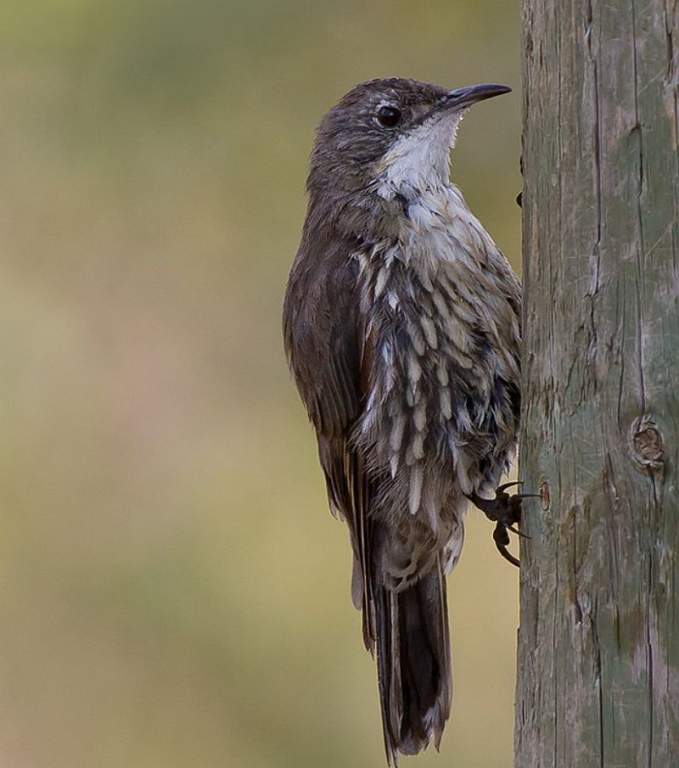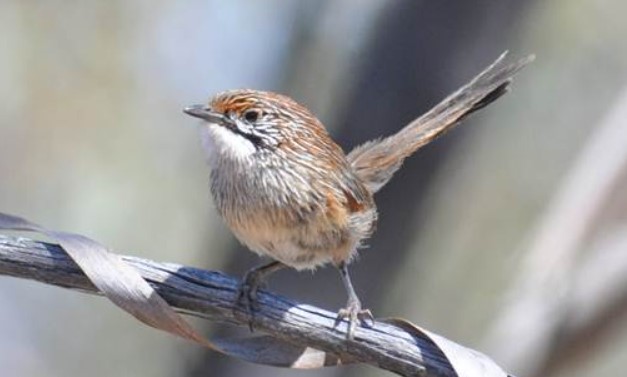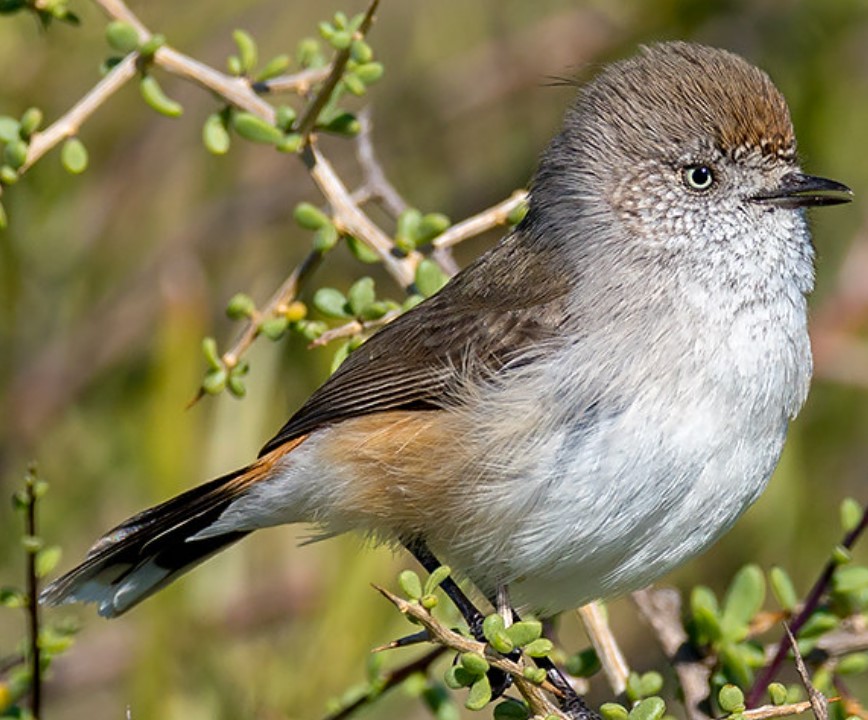Family: The White-throated Treecreeper (Cormobates leucophaea) is the most acrobatic member of the family “Climacteridae” of the genus Cormobates.
Habitat: White-throated treecreepers’ preferred habitat is wet sclerophyll woodland and rainforest. Every bird lover knows that treecreepers are small, brownish birds with rather long curved bills, large feet, and a pale buff bar in the wing that shows in flight. Confined to Australia and Papua New Guinea. They hunt for food on tree trunks and large branches, which they climb without using their tails for support. Their method is simple. They ascend the tree gradually, either by going straight up or by swaying from side to side. When they reach their destination, they take off and land at the base of the following tree to begin the process anew.
Behavior: At night they sleep, clinging upright, on the surface of tree trunks in bark crevices or burnt-out basal hollows; even crevices in the walls of buildings have been used. A bird of the wetter forests of the east coast and outlying ranges, the White-throated is much the most solitary of the treecreepers, to the point of being antisocial.
When moving along an outward-sloping limb, it works as much along the underside as the upper, investigating areas inaccessible to most birds. As it moves up the tree, it explores crevices or cracks in the trunk and areas of peeling bark, probing and testing the surface with its rather thin bill, which is thinner and slightly more down-curved than those of other treecreepers. It sometimes hammers briefly at a particularly likely-looking spot or even probes with its tongue into deep crevices the bill cannot plumb. Occasionally, it snatches an insect from a leaf or thin twig, and on rare occasions, it may even probe into a flower, such as a banksia, as a honeyeater does.
White-throated Treecreepers climb in an unusual way, like all treecreepers. The bird maintains the lead foot position by keeping one foot ahead of the other, then elevating the rear foot to meet the front foot, and vice versa. At times the left foot will be ahead, at others the right, but the bird does not walk up the tree with one foot ahead of the other in sequence, nor does it hop with both feet together. Instead, it is a sluggish, shuffling gallop, and the feet, which have skin-bound front toes, grasp like calipers. The bird’s large, strong feet and claws also enable it to hang vertically upwards on a trunk, but like other treecreepers, it cannot reverse itself and hang downwards like a sittella.
It shuffles up and down the tree, although it moves only upwards most of the time. Every year, pairs protect a certain area that they both sing about from vantage points on trunks and branches. With each measured note, the singer jerks its tail abruptly downward. Early in the mating season, the male announces his offering with a quick trill before feeding his partner regularly.
From selected perches, he gives whistled crescendos and a remarkable pre-mating display. The head is dropped, and the wings tremble with each call. If the female arrives, he spreads his wings horizontally and raises his tail, then gradually rocks from side to side, waving one or both wings. Copulation may follow.

Races: The northernmost race of this species is the Little Treecreeper (C. l. minor), which is largely confined to highland rainforests (above 300–350 meters) but also inhabits eucalypt forests on the ranges in northern Queensland. It is smaller and darker than the White-throated Treecreeper found in the southeast, although it is similar in other ways as well, such as vocal. Intermediate populations in central and southeastern Queensland and northeastern New South Wales connect the two kinds. The Papuan Treecreeper of montane New Guinea rainforests is also sometimes treated as a race of the White-throated, but it is much smaller and more russet brown, with a brown rump and differently marked crown. Molecular research on the two taxa is still pending.
Identification: There is a variation in males and females.
Male: upper parts deep olive-brown; rump grey; forehead and forecrown feathers edged buff, giving a scaly appearance; lores off-white. Wings are dusky, with a buff band across flight feathers and a pale grey trailing edge. Tail mid-grey with broad black subterminal band on all but the central pair of feathers. Throat and center breast are white, becoming creamy yellow on the belly; variable wash of brown-grey across the breast; sides of the breast and flanks drop-spotted cream-white on the dusky. Undertail buff-white with broken black crossbars. The eyes are brown. The bill is dusky; the base of the lower mandible is grey-white. The feet are deep olive-grey-brown. Northeastern Queensland races south to Eungella, darker above, throat grey-white, broad deep brown-grey breast band, belly heavily mottled olive-brown, cream, and dusky.
Female: As male; a rusty-orange spot on the lower cheek, larger in young birds.
Immatures: As adults, but black-edged whitish streaks on scapulars in most birds; upper parts barred faintly dusky in males; rump bright rufous in females. Adult plumage increased gradually at the first annual molt, several months after fledging.
Vocalizations: White-throated Treecreeper calls consist of a series of piping whistles quickly repeated, the first descending in pitch then flattening out, or uttered singly, by both sexes, probably both to advertise territory and maintain contact; also soft buzz and kookaburra-like chuckle.
SONG: Males give a repeated series of up to 10 upward-inflected whistled notes with a slight crescendo in the display, as well as rapid trills and soft upward-inflected hits, quickly repeated. Females give a melodious succession of whistled notes, descending in scale and slowing down; during the incubation period, they give soft, morse code-like notes.
Juveniles give a soft trill reminiscent of a fan-tailed cuckoo (Cacomantis flabellzformis).

Diet: Treecreepers feed on a wide variety of insects and spiders, but ants—the most conspicuous and numerous of tree-trunk insects—are the chief item in their diet. Unlike other treecreepers, the white-throated hardly ever feeds on the ground; it feeds on prevailing rainforest trees and rough-barked eucalypts: stringybarks, peppermints, and iron barks. In rainforests, clumps of arboreal moss and lichens are found. It feeds alone except briefly during breeding, and even mated birds keep well away from one another at most times. Trespass is met with aggressive chases, loud calls, and a strange clicking noise made by the abrupt spreading of the tail. A female was seen consuming a bracket fungus called white punk (Laetiporus portentosus).
Distribution: White-throated Treecreeper is found in rainforests and wet and dry sclerophyll forests with rough-barked eucalypts around the east coast of the mainland and nearby ranges, north to tablelands near Cooktown, Queensland, and southwest to southeast and Mt Lofty Ranges, Gulf St Vincent in South Australia. Restricted to montane forests north of 25°S. This species is protected in Australia under the National Parks and Wildlife Act of 1974.
Nesting and Breeding: white-throated treecreeper nesting and breeding occur in August–December. Nest in a hollow tree hollow, often filled with debris; a cup lined with hair, moss, fur, or feathers. Nests are normally built in tree holes or stumps, but this treecreeper will also build behind loose pieces of bark and in artificial nest boxes. Usually, only one brood is reared per season.
Eggs: White-throated The treecreeper lays two or three, rarely four, eggs, which are white to creamy white, sparingly dotted with dark red-brown or purplish-black, mostly at the larger end; they are oval, about 22 x 17 mm. The incubation period is about 22–23 days for females. Young fledge in about 25–26 days. Only the female builds the nest and incubates, laying each egg in the clutch at 48-hour intervals. When she emerges after a sitting, she often emits a single loud note, then forages with her mate, uttering a soft twitter periodically. Both sexes care for the young, which beg loudly with a distinctive chatter, audible from some distance.
Flight: The white-throated treecreeper flight is direct, with bursts of whirring stiff-winged beats interspersed with planning glides.
Other Names: The bird is also known as the Little Treecreeper, or ‘Woodpecker’.
Size: White-throated Treecreeper measures about 140–170 mm in length with a wingspan of 19–26 cm, averaging 23 cm, and averaging 22 grams in weight.
Similar species: Red-browed Treecreeper
Status: The population is stable; hence, it is the least concerned on the list of IUCN.
Domain: Eukaryota
Synonyms: Climacteris leucophaeus
Kingdom: Animalia
Binomial name: Cormobates leucophaea (Latham, 1801)
Phylum: Chordata
Class: Aves
Species: C. leucophaea
Order: Passeriformes







